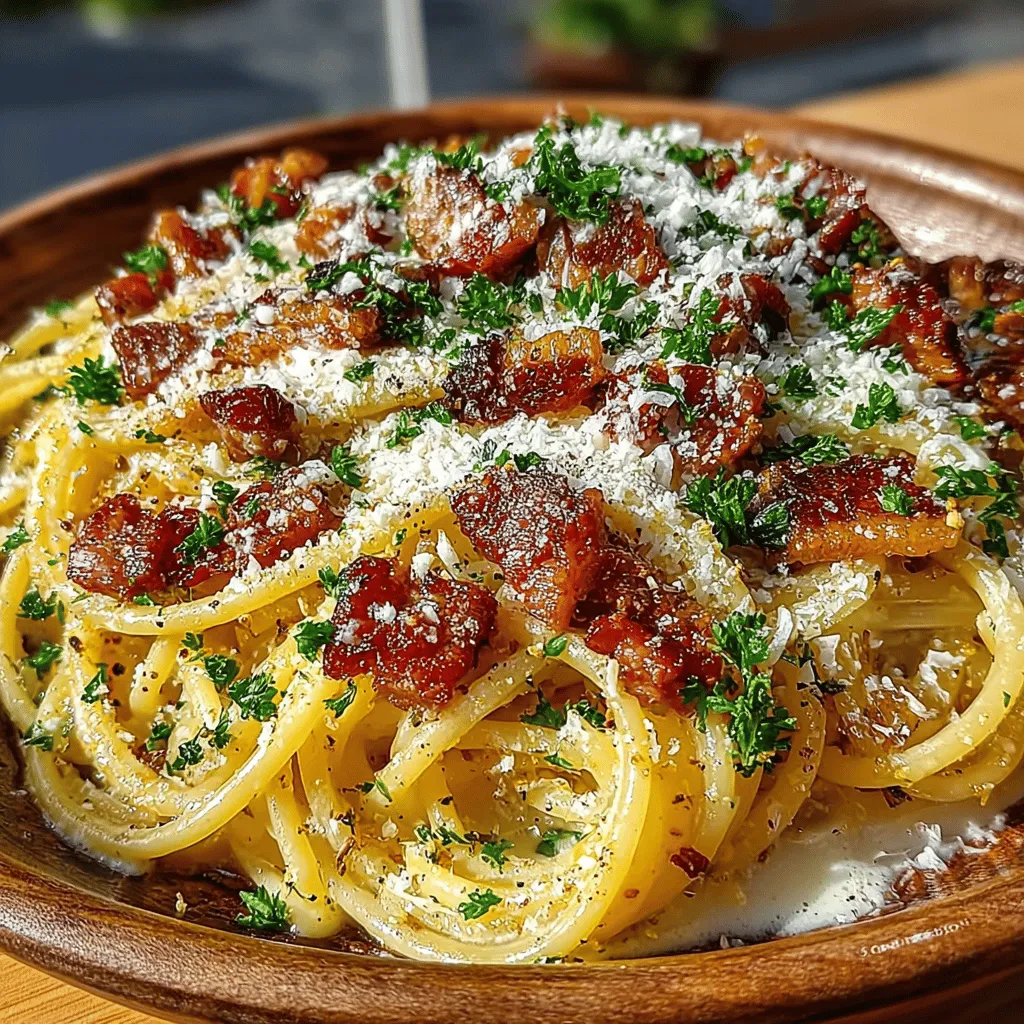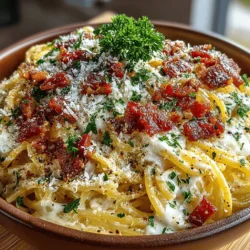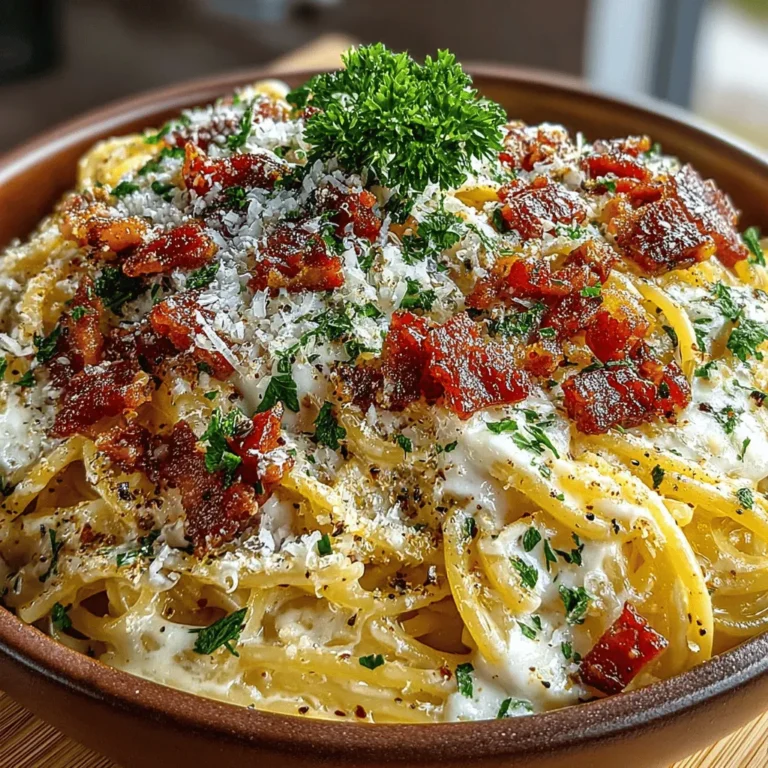Spaghetti Carbonara Bliss: A Classic Italian Recipe
When it comes to iconic Italian dishes, few can rival the rich, creamy indulgence of Spaghetti Carbonara. This beloved classic, known for its simplicity and depth of flavor, has captured the hearts (and stomachs) of food enthusiasts around the world. Originating from the heart of Italy, Spaghetti Carbonara is a perfect representation of how a few high-quality ingredients can come together to create a dish that is both comforting and sophisticated.
The magic of Carbonara lies in its authentic ingredients and traditional techniques. While the recipe may seem straightforward, achieving the perfect Carbonara requires a keen understanding of how each component interacts to create a harmonious blend of flavors. From the choice of pasta to the method of preparation, each step is crucial in crafting a plate of spaghetti that honors its origins while delighting the palate.
This dish is not just about the ingredients; it embodies the essence of Italian cooking—simplicity, quality, and a celebration of flavor. With only a handful of components, Spaghetti Carbonara showcases how the right techniques can elevate the simplest of meals into something extraordinary.
Understanding Carbonara: The Heart of Italian Cuisine
To fully appreciate Spaghetti Carbonara, it’s essential to delve into its historical context. The origins of this dish are somewhat shrouded in mystery, with several theories about its inception. Some believe it was first created by Italian charcoal workers (“carbonari”) in the Apennine Mountains, while others argue that it emerged in Rome shortly after World War II, influenced by American soldiers who introduced bacon and eggs to local cuisine.
As its popularity grew, so did the variations of the dish. While the classic Roman recipe remains the most celebrated, regions across Italy have put their own spin on Carbonara, often incorporating local ingredients. Despite these variations, what remains constant is the dish’s core components, which are essential for achieving that signature creamy texture without the use of cream—a common misconception.
Key Ingredients That Define Traditional Carbonara
The beauty of Carbonara lies in its minimalism, relying on a few key ingredients that come together in a symphony of flavors. Understanding these components is crucial for making an authentic Spaghetti Carbonara.
1. Spaghetti:
Choosing the right type of pasta is fundamental to the dish. While spaghetti is the traditional choice, other long pasta varieties like fettuccine or bucatini can also work. The pasta should be cooked to an al dente texture, allowing it to hold up against the rich sauce while absorbing the flavors.
2. Pancetta or Guanciale:
One of the most significant decisions when making Carbonara is selecting between pancetta and guanciale. Guanciale, an Italian cured meat made from pork cheek, is the traditional choice and imparts a unique sweetness and depth of flavor. Pancetta, which is made from pork belly, is more accessible outside Italy and can be used in a pinch, though it lacks the same complexity. The choice of meat will significantly impact the final taste of your Carbonara.
3. Eggs:
The eggs play a crucial role in creating the creamy sauce that clings to the pasta. Using fresh, high-quality eggs is essential, as they provide the richness and texture necessary for a velvety Carbonara. Some chefs prefer using only egg yolks for a richer sauce, but a combination of whole eggs and yolks can also deliver excellent results.
4. Cheeses:
While Pecorino Romano is the traditional cheese for Carbonara, a sprinkle of Parmigiano-Reggiano can enhance the flavor profile. Pecorino Romano, a sharp and salty sheep’s milk cheese, is key to achieving the authentic taste of the dish. Be sure to grate the cheese fresh, as pre-grated varieties often contain anti-caking agents that can affect the sauce’s consistency.
5. Seasonings:
The seasoning in Carbonara is deliberately kept simple. Freshly cracked black pepper adds warmth and depth, while a pinch of salt is necessary for boiling the pasta. Garlic is not traditionally used in authentic recipes, but some cooks may add it for an extra layer of flavor, although it’s best to keep it subtle.
6. Optional Garnish:
For those looking to elevate their Carbonara further, a sprinkle of fresh parsley can add a pop of color and a hint of freshness. This optional garnish not only enhances presentation but can also complement the rich flavors of the dish beautifully.
Gathering the Ingredients for Your Carbonara
Now that you understand the essence of Spaghetti Carbonara, it’s time to gather your ingredients. Here’s a detailed breakdown of what you’ll need to create this Italian masterpiece:
– Spaghetti: Opt for high-quality dried spaghetti, typically made from durum wheat. Look for brands that emphasize traditional methods for the best texture.
– Pancetta or Guanciale: If you can find it, guanciale is the gold standard. Look for it at specialty Italian markets or gourmet grocery stores. If unavailable, pancetta is a more common substitute but be aware of the flavor difference.
– Eggs: Choose large, free-range eggs for the best flavor and quality. The freshness of the eggs will greatly enhance the dish’s richness.
– Pecorino Romano: Purchase a block of Pecorino Romano and grate it freshly. This cheese is a staple in Roman cuisine and is essential for authentic flavor.
– Black Pepper: Use whole peppercorns and grind them fresh for the best taste. The aroma of freshly cracked pepper will elevate your Carbonara.
– Optional Fresh Parsley: If you enjoy a hint of green, fresh parsley can be chopped and used as a garnish just before serving.
Step-by-Step Cooking Instructions
With your ingredients gathered, you’re ready to embark on the culinary journey of preparing Spaghetti Carbonara. The first step is to prepare the pasta.
Preparing the Pasta:
1. Boiling the Water: Fill a large pot with water, adding a generous amount of salt (about 1-2 tablespoons). Bring the water to a rolling boil before adding your spaghetti.
2. Cooking the Spaghetti: Once the water is boiling, add the spaghetti and cook according to the package instructions until it reaches al dente. Typically, this will be around 8-10 minutes, but it’s crucial to taste the pasta a minute or two before the recommended time to ensure it’s cooked to your preference.
3. Reserving Pasta Water: Before draining the spaghetti, reserve about a cup of the starchy pasta water. This water will be essential for adjusting the sauce’s consistency later.
As you prepare the pasta, you can start crafting the sauce.
Crafting the Sauce:
1. Cooking the Meat: In a large skillet over medium heat, add diced pancetta or guanciale. Cook until it becomes crispy and golden, releasing its flavorful fat. This step is vital, as the rendered fat will serve as the base for your sauce.
2. Whisking the Eggs and Cheese: In a mixing bowl, combine the eggs and grated Pecorino Romano. Whisk vigorously until the mixture is well combined and creamy. This will be the sauce that coats your spaghetti.
3. Combining Ingredients: Once the pasta is cooked and drained, transfer it directly to the skillet with the rendered meat. Remove the skillet from the heat to prevent the eggs from scrambling. Quickly pour the egg and cheese mixture over the hot pasta, tossing vigorously to combine. The heat from the pasta will gently cook the eggs, creating a silky sauce.
4. Adjusting Consistency: If the sauce seems too thick, add a small amount of the reserved pasta water, a tablespoon at a time, until you achieve the desired creaminess. The sauce should cling to the spaghetti without being soupy.
At this point, your Spaghetti Carbonara is nearing completion. The combination of crispy pancetta or guanciale, the richness of the eggs, and the sharpness of the Pecorino Romano will create a mouthwatering dish that is sure to impress.
In the next part of this article, we will explore additional tips for perfecting your Carbonara, including variations and serving suggestions that will elevate this dish to new heights. Stay tuned to discover how to make your Spaghetti Carbonara not just a meal, but a culinary experience.

Mixing Eggs and Cheeses: Techniques for Achieving Creaminess
Creating a luscious, creamy sauce is the heart of a successful Spaghetti Carbonara. The combination of eggs and cheese—typically Pecorino Romano and Parmigiano-Reggiano—creates a rich texture that clings beautifully to the pasta.
To achieve the ideal creaminess, start by whisking the eggs in a bowl until they are fully blended. Add finely grated cheese to the eggs and mix until you have a smooth paste. The fine grating of the cheese is crucial here; it not only helps it melt quickly but also ensures an even distribution throughout the sauce.
For an extra touch of creaminess, consider adding a tablespoon of heavy cream, although traditionalists may argue against this. If you do choose to add cream, be sure to adjust the amount of cheese slightly to maintain a balanced flavor.
Importance of Timing in the Cooking Process
Timing is everything in cooking, especially in a dish like Carbonara where ingredients need to come together at the right moment. Start boiling the water for your pasta before you cook the pancetta or guanciale. This ensures that everything is ready to combine shortly after your pasta is cooked.
Once your pasta is al dente, you will need to act quickly to marry the hot pasta with the egg and cheese mixture. If you let the pasta cool too much, it won’t properly cook the eggs, which can lead to a scrambled texture instead of a creamy sauce.
Cooking the Pancetta/Guanciale: Techniques for Achieving the Ideal Crispy Texture
The choice between pancetta and guanciale will affect both the flavor and texture of your Carbonara. Guanciale, made from pork cheek, offers a richer taste and a slightly firmer texture. Pancetta, on the other hand, is from the pork belly and is a bit softer.
To achieve the perfect crispy pancetta or guanciale, start by cutting it into small cubes or strips. Heat a large skillet over medium heat and add the meat without any added oil; the fat will render out as it cooks. Stir occasionally to ensure even cooking.
Cook until the meat is golden brown and crispy, about 5-7 minutes. If using guanciale, look for a nice caramelization, which enhances the flavor. Once done, remove the skillet from heat, but leave the meat in the pan to retain the rendered fat for flavoring the sauce.
Adding Garlic: When and Why to Incorporate for Flavor
Garlic can elevate the flavor profile of your Carbonara, providing a subtle aromatic quality. However, timing is key. You want to add the minced garlic to the pan just after the pancetta or guanciale has cooked.
Allow the garlic to cook in the rendered fat for about 30 seconds—just enough time for it to become fragrant without burning. Overcooking garlic can lead to bitterness, so keep a close eye on it. This step adds depth to your dish without overpowering the traditional flavors of Carbonara.
Combining Ingredients: How to Blend Pasta with the Sauce for the Best Texture
The moment of truth arrives when you combine your pasta with the pancetta and the egg mixture. First, use a slotted spoon to transfer your spaghetti directly from the boiling water into the skillet with the cooked pancetta and garlic. This allows some pasta water to carry over, which is essential for adjusting the sauce’s consistency.
Toss the pasta in the skillet over low heat to combine it with the pancetta, ensuring the pasta is well coated with the rendered fat. Then, take the skillet off the heat to prevent the eggs from scrambling when you add the egg and cheese mixture.
Pour the egg mixture over the pasta, and quickly toss everything together. The residual heat from the pasta will gently cook the eggs, creating a creamy sauce. If the sauce appears too thick, gradually add reserved pasta water, one tablespoon at a time, until you achieve the desired consistency.
Final Seasoning and Presentation: The Role of Salt and Pepper in Enhancing Flavors
Once your pasta is fully coated and creamy, it’s time to season. Be cautious with salt, as both your cheese and pancetta contribute saltiness. Instead, focus on freshly cracked black pepper, which is essential in Carbonara. Generously add a few twists of the grinder and mix well.
For an attractive presentation, serve the Carbonara in warm bowls. Top each portion with a sprinkle of extra cheese and a few more twists of black pepper for visual appeal. Consider garnishing with fresh parsley or basil for a pop of color, though this is optional.
The Art of Perfecting Your Carbonara
Common Pitfalls to Avoid When Making Carbonara
While making Carbonara may seem straightforward, there are common mistakes to watch out for. First, avoid overcooking the pasta; it should be al dente to hold up against the sauce.
Another pitfall is allowing the egg mixture to cook too long on the heat, leading to scrambled eggs rather than a creamy sauce. Always remove the skillet from heat before adding the egg mixture.
Lastly, be mindful of the cheese; using pre-grated cheese can lead to a grainy sauce, so always opt for fresh grating.
Importance of Temperature Control During the Mixing Process
Temperature control is crucial in ensuring the eggs don’t scramble when mixed with the hot pasta. As previously mentioned, always remove the skillet from direct heat before adding the egg and cheese mixture. This prevents the proteins in the eggs from coagulating too quickly, allowing you to achieve that desirable creamy texture.
Variations to Consider for Personal Tastes
While traditional Spaghetti Carbonara is a beloved classic, feel free to experiment with variations to suit your taste. For a vegetarian option, consider substituting the pancetta with sautéed mushrooms or even roasted vegetables.
You can also explore different meats, such as bacon or turkey bacon, though these will alter the flavor profile slightly. For a twist, some people enjoy adding peas or asparagus for a touch of color and extra nutrition.
Nutritional Information and Serving Suggestions
Breakdown of Nutritional Information Per Serving
For a standard serving of Spaghetti Carbonara, you can expect approximately:
– Calories: 550
– Protein: 25g
– Carbohydrates: 60g
– Fat: 25g
– Fiber: 2g
These values can vary slightly based on ingredient choices and portion sizes, so it’s helpful to adjust according to personal dietary needs.
Best Side Dishes and Wines to Pair with Spaghetti Carbonara
Spaghetti Carbonara pairs beautifully with a variety of side dishes. A simple arugula salad dressed in lemon vinaigrette complements the rich flavors of the Carbonara. Garlic bread is another excellent choice, providing a crunchy contrast to the creamy pasta.
As for wine, a crisp white such as Pinot Grigio or a light red like Chianti enhances the dish without overwhelming it.
Discussing Portion Sizes and Serving Options for Family Meals or Gatherings
This recipe serves four, making it perfect for family dinners or small gatherings. When serving, consider portion sizes to ensure everyone enjoys a satisfying meal. For larger gatherings, you can easily double the recipe, keeping in mind the cooking times and the need for larger pots.
Conclusion
Making homemade Spaghetti Carbonara is not just about preparing a meal; it’s about embracing the authentic flavors of Italian cuisine. The combination of creamy sauce, crispy pancetta, and perfectly cooked pasta creates a dish that warms the heart and satisfies the palate.
As you embark on your Carbonara journey, remember to focus on quality ingredients and timing to achieve the best results. With practice, you will master this classic dish and bring the warmth of Italy into your home. So gather your loved ones, share a plate of Spaghetti Carbonara, and enjoy the delightful simplicity of this timeless recipe.


